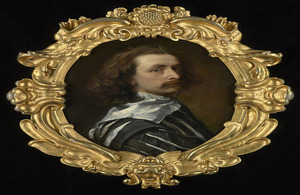Last chance to keep stunning Van Dyck painting in the UK
Ed Vaizey temporarily blocks Van Dyck export

Van Dyck self portrait
A self-portrait by Sir Anthony Van Dyck (1599-1641), one of his finest and most intimate works dating from his time in the UK, has had a temporary export bar placed on it to provide a last chance to raise the £12,500,000 needed to keep it in the UK.
Culture Minister Ed Vaizey took the decision to defer granting an export licence for the painting following a recommendation by the Reviewing Committee on the Export of Works of Art and Objects of Cultural Interest (RCEWA), administered by Arts Council England, on the grounds of its strong connection with our history and national life, its outstanding aesthetic importance and its outstanding significance for the study of seventeenth-century portraiture.
Van Dyck played a pivotal role in the development of portraiture in Britain during the time he spent here (1620-21, 1632-35, 1635-41), and was held in high regard by King Charles I who awarded him a knighthood, a home and an annuity in 1632. Although Van Dyck produced a number of self-portraits during his career, this example is widely regarded as one of the finest and is acknowledged as being a source of inspiration to other artists. Comparisons with other self-portraits of the period immediately highlight the ingenuity and technical accomplishment of this work.
Culture Minister Ed Vaizey said:
“ We have recently had a number of successes in preventing national treasures from being permanently exported from the UK thanks to the generosity of donors and the fundraising efforts of our museums and galleries. I hope that placing a temporary export bar on this magnificent painting will allow time for a UK buyer to come forward and ensure it remains here in the UK.”
RCEWA Member Lowell Libson said:
“ This portrait is a profoundly personal and impressive demonstration of Van Dyck’s confidence as a painter and with his deft manipulation of paint he created the illusion that the viewer is encountering the subject directly. Van Dyck’s self-portrait is a notable expression of the talents and character which catapulted him to fame in the Courts of Europe.”
The decision on the export licence application for the painting will be deferred for a period ending on 13th February 2014 inclusive. This period may be extended until 13th July 2014 inclusive if a serious intention to raise funds to purchase the painting is made at the recommended price of £12,500,000 (plus 5% import VAT).
For media information contact: Tamara Salhab, Media Relations Officer, Arts Council England Tel: 020 7973 5189 or 07872 416679 Email: tamara.salhab@artscouncil.org.uk
Notes to Editors
-
Organisations or individuals interested in purchasing the painting should contact the RCEWA on 0845 300 6200.
-
The Reviewing Committee on the Export of Works of Art and Objects of Cultural Interest is an independent body, serviced by Arts Council England, which advises the Secretary of State for Culture, Media and Sport on whether a cultural object, intended for export, is of national importance under specified criteria.
-
Arts Council England champions, develops and invests in artistic and cultural experiences that enrich people’s lives. Between 2010 and 2015, it will invest £1.9 billion of public money from government and an estimated £1.1 billion from the National Lottery to help create these experiences for as many people as possible across the country. www.artscouncil.org.uk